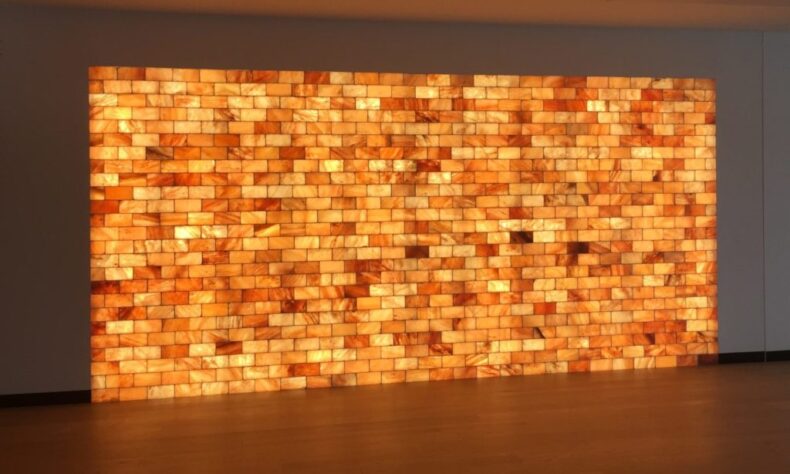
Eco-Friendly Art Design.
The increasing concern for environmental sustainability has led to a growing trend of eco-friendly art and design practices. Artists and designers are seeking innovative ways to incorporate sustainable materials into their creations, and one such material that has gained significant attention is Himalayan salt tiles. Salt tile installations offer a unique appeal that combines aesthetics, environmental consciousness, and functionality. These installations can transform spaces into visually captivating environments while contributing to a sustainable future.
Himalayan salt tiles, also known as salt bricks or blocks, are crafted from natural salt deposits. They possess a distinct translucent quality that allows them to create a mesmerizing play of illumination when exposed to light. This inherent luminosity makes salt tiles an attractive medium for artists and designers. The natural beauty and texture of salt tiles and their eco-friendly characteristics make them a compelling choice for creating visually captivating installations.
Understanding Himalayan Salt Tiles and Their Environmental Benefits
Composition and Sourcing of Salt Tiles
Himalayan salt tiles are typically made from pure rock salt, primarily sodium chloride. These natural salt deposits are formed over thousands of years through the evaporation of seawater or saltwater lakes. The unique mineral composition of salt tiles gives them their distinctive translucent appearance, allowing light to pass through and create stunning visual effects.
Sourcing salt tiles is a vital aspect to consider in their environmental impact. Himalayan Salt tiles should be sourced from sustainable salt mines or salt flats, where extraction methods prioritize minimal disruption to the natural ecosystem. Responsible sourcing ensures the preservation of natural resources and minimizes environmental damage.
Sustainable Production Methods
Salt-tile production often involves traditional and artisanal techniques, minimizing energy use and reducing carbon emissions. Artisans handcraft the tiles by carefully extracting blocks of salt and shaping them into desired forms. This manual labor approach adds a unique artistic touch and ensures a low environmental impact during the manufacturing process.
In addition to the sustainable production methods, some manufacturers have further enhanced salt tiles’ eco-friendliness. For example, they employ solar-powered facilities, use energy-efficient machinery, and implement water conservation practices. By prioritizing sustainable production methods, the environmental footprint of salt tile manufacturing can be significantly reduced.
Biodegradability and Recycling Potential of Himalayan Salt Tiles
One of the remarkable environmental benefits of salt tiles is their biodegradability. Over time, salt tiles naturally dissolve when exposed to moisture, returning to their original state as salt. This biodegradability ensures that salt tiles do not contribute to long-term waste accumulation and aligns with the principles of a circular economy.
Furthermore, Himalayan salt tiles have recycling potential. When tiles are no longer needed or damaged, they can be crushed and repurposed. The crushed salt can be used for various applications, such as de-icing roads or as a natural scrubbing agent. Recycling salt tiles further reduces waste and extends their usefulness beyond their original purpose.
Environmental Impact of Salt Tiles
Salt tile installations offer a variety of eco-friendly benefits that make them a sustainable choice for artists, designers, and architects. Examining their environmental impact makes it apparent how salt tiles contribute to a greener and more sustainable future.
Energy Efficiency and Carbon Footprint
One significant advantage of salt tile installations lies in their energy efficiency. The translucent nature of Himalayan salt tiles allows them to transmit and diffuse natural light, reducing the need for artificial lighting during daylight hours. By maximizing natural light, salt tiles help decrease energy consumption and lower the carbon emissions associated with artificial lighting systems. Numerous studies have demonstrated that incorporating natural light in architectural designs can result in substantial energy savings and contribute to a more sustainable built environment.
Moreover, the production process of salt tiles requires minimal energy. Skilled artisans shape and craft the tiles by hand, employing traditional techniques that consume less energy than industrial manufacturing processes. Consequently, the carbon footprint associated with salt tile production is significantly reduced compared to other building materials.
Sustainable Material and Resource Conservation
Salt tiles are sourced from natural salt deposits, which are abundant and renewable resources. Unlike conventional construction materials that require extensive mining or extraction, Himalayan salt tiles are derived from naturally occurring salt formations that replenish over time. This ensures salt’s sustainability and long-term availability as a material for artistic and architectural applications.
Additionally, salt extraction for tile production often involves low-impact mining practices prioritizing environmental preservation. Responsible salt mining techniques minimize disturbances to ecosystems, promote the reclamation of mining sites, and ensure the protection of surrounding habitats. These sustainable practices help preserve biodiversity and minimize the ecological footprint associated with salt tile production.
Indoor Air Quality and Health Benefits
Himalayan salt tiles have been linked to several health benefits, particularly in relation to indoor air quality. The hygroscopic nature of salt allows it to attract and retain moisture from the surrounding environment. As a result, salt tiles can help regulate humidity levels by absorbing excess moisture and releasing it when the air becomes dry. This natural humidity regulation can provide a more comfortable indoor environment and help prevent mould growth and respiratory problems.
Moreover, salt possesses natural antibacterial and antimicrobial properties. When salt tiles are exposed to air, they can release negative ions that have been shown to reduce airborne pollutants and allergens. These negative ions can improve indoor air quality, particularly in spaces with a higher concentration of pollutants, such as exhibition halls or public areas. Studies have indicated that negative ions can have a positive impact on mood, well-being, and overall air quality.
The Aesthetic Allure of Salt Tile Installations
Salt tile installations have a distinct and visually captivating aesthetic charm distinguishing them from traditional materials. Their innate beauty, transparency, and ability to create stunning visual effects make them preferred among artists, exhibition designers, and architects who aim to fashion visually captivating and immersive spaces.
Unveiling the Natural Beauty and Translucency
Himalayan salt tiles exude a natural allure stemming from their unique mineral composition. The translucent quality of salt allows light to permeate, casting a gentle, warm radiance when illuminated. This inherent luminosity imparts an ethereal and mesmerizing ambience to salt tile installations. Salt tiles’ textures and colour variations further accentuate their natural beauty. Each tile showcases distinctive patterns and textures, ranging from sleek and glass-like to intricate and crystalline surfaces. These variations enhance visual interest and depth within installations, offering a captivating visual experience from diverse perspectives.
Unleashing the Interplay of Light and Shadow
Among the most enchanting aspects of salt tile installations is the captivating interplay of light and shadow they conjure. Light graces the Himalayan salt tiles and permeates the translucent surface, casting intricate patterns and shadows. These dynamic light arrangements evolve throughout the day, creating a mesmerizing dance between light and shadow. Artists and designers can strategically position salt tiles to harness this interplay of light and shadow. By thoughtfully considering the placement of light sources and the orientation of the tiles, they can manipulate the visual effects and fabricate captivating displays that evolve harmoniously throughout the day.
Exploring the Intricate Textures and Patterns
Salt tiles offer diverse textures and patterns that can be explored within installations. The inherent variations in texture and crystalline patterns within each tile contribute to the overall visual allure. Artists can experiment with different arrangements and combinations of tiles, crafting unique patterns and textures that add depth and visual fascination to their installations. Additionally, Himalayan salt tiles can be intricately carved or sculpted to fashion elaborate designs or personalized textures. This artistic liberty empowers creators to unleash their imagination, producing bespoke installations that embody their artistic vision. The malleability of salt tiles offers boundless opportunities for fabricating visually captivating and genuinely one-of-a-kind artworks.
Moreover, the integration of salt tiles in art exhibits and public displays has garnered recognition and acclaim within the artistic community. Prominent art galleries, museums, and design events have featured salt tile installations, further attesting to their aesthetic allure and ability to captivate audiences.
Conclusion
In conclusion, salt tile installations offer a compelling combination of eco-friendly benefits and aesthetic allure, making them a versatile and captivating choice for artists, exhibition designers, and architects. The unique properties and characteristics of salt tiles highlight their natural beauty, luminosity, and tactile qualities. Himalayan Salt tiles have been found to possess therapeutic properties, contribute to better air quality, and create a sense of tranquility. Salt tiles can significantly reduce energy consumption, carbon emissions, and reliance on artificial lighting systems. Additionally, salt tiles are sourced from abundant and renewable salt deposits, minimizing the environmental impact associated with their production. Salt tiles offer a unique and captivating aesthetic experience, attracting viewers with their natural beauty, the captivating play of light and shadow, and the ability to create visually stunning installations. Supported by scientific research, salt tile installations have been shown to evoke positive emotional responses and enhance the overall sensory experience through their combination of eco-friendliness and aesthetic appeal, salt tile installations open new possibilities for creating sustainable and visually captivating artistic and architectural works.





